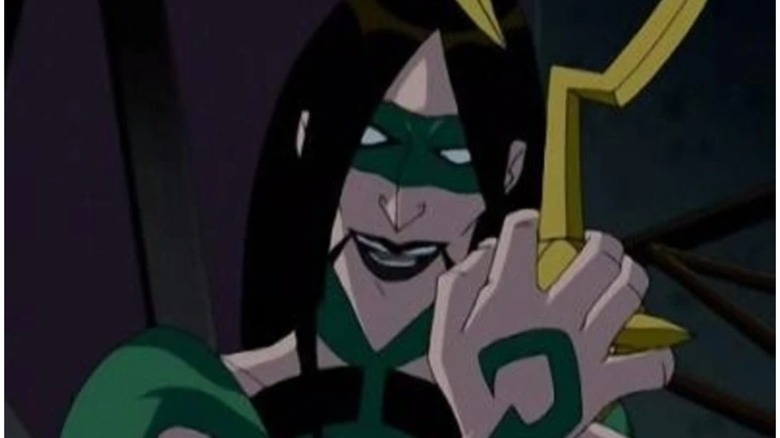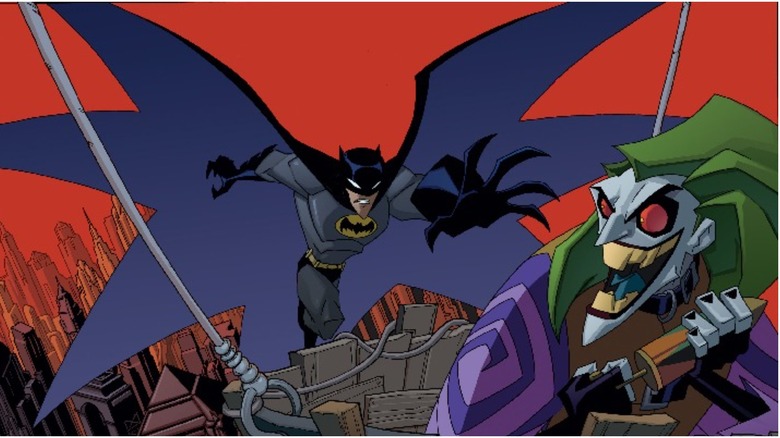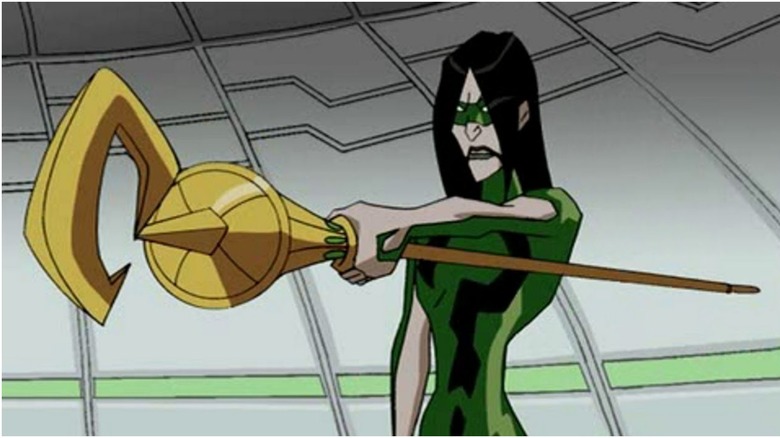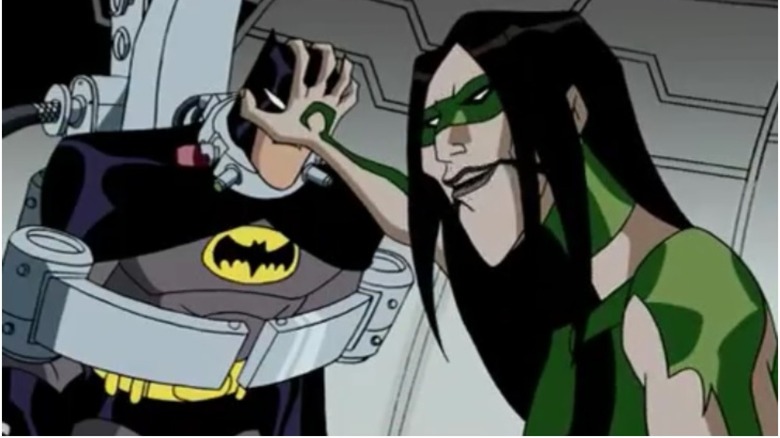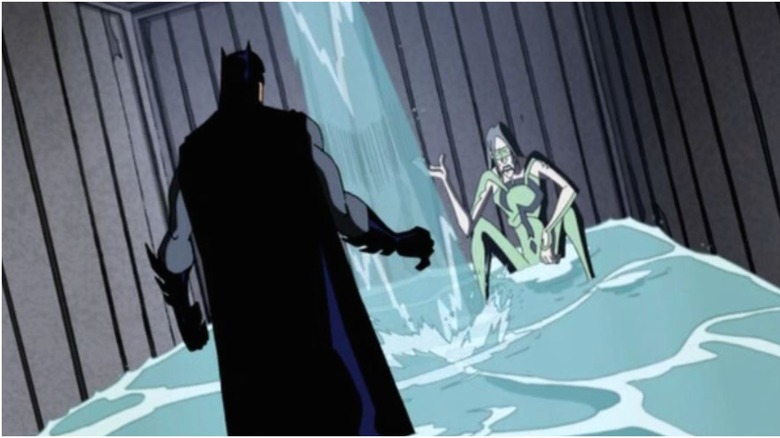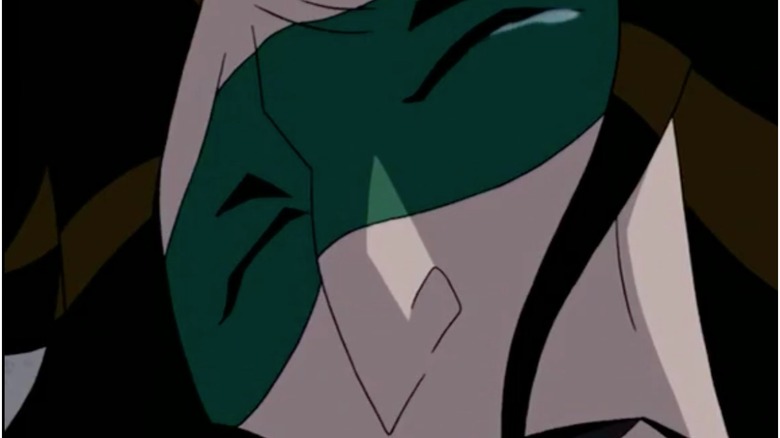Robert Englund's Riddler Is Seriously Underrated
Robert Englund's addition to the cast of "Stranger Things" season 4 is just perfect— a fantasy horror series built on 1980s nostalgia would be incomplete if it didn't bring in Freddy Krueger himself. Englund has played the dream-stalking serial killer in eight movies, the short-lived anthology series "Freddy's Nightmares," and plenty of parodies. The actor will be forever defined by Freddy, something he's embraced, but this doesn't mean he's a one-trick-pony.
Englund is classically trained, for one, and in his early career, he was primarily a stage actor. Like most genre performers, he's also given voice-acting a shot, a path that's led him on a few jaunts through the DC Universe. Among his comic book-inspired roles are the evil wizard Felix Faust in the animated "Justice League" series and the Scarecrow in the video game "Injustice 2." That latter character is a natural fit — Jonathan Crane is easily the Batman rogue closest to Freddy.
However, Englund had an even better turn as a Batman villain years prior, when he voiced ol' Eddie Nygma, aka the Riddler on "The Batman." Englund wasn't as obvious a pick for Riddler as he was for Scarecrow; Riddler usually isn't one of the scarier Batman villains. However, Englund has a comic spirit as well, as he demonstrated as the "Nightmare" movies got progressively sillier. What makes his Riddler so grand is how he built the same bridge between camp and creepy that he had with Freddy.
How The Batman Was Different
"The Batman" lived in the shadow of "Batman: The Animated Series." With so much to live up to, the series sometimes felt like it was different just for the sake of being different. It was the first time since 1992 that Kevin Conroy and Mark Hamill weren't voicing Batman and the Joker, respectively; Rino Romano and Kevin Michael Richardson took over those roles. Romano and Richardson's performances represent "The Batman" as a whole; they don't surpass their predecessors, but they're unique takes that stand on their own merits.
The series also featured a younger Batman. "Animated Series" Batman had been crime-fighting for well over a decade when we met him in the pilot, "On Leather Wings." In "The Batman," Bruce has only been the Dark Knight for three years. Casting Rino Romano, who was younger than Conroy and sounds it, reflects this rookie characterization.
"The Batman" also feels more like a more typical cartoon than "Batman: The Animated Series," with more simplistic storytelling and a greater focus on action. The latter featured formula-breaking episodes like "Almost Got 'Im," where Gotham's worst swap stories of times they came close to besting Batman, or "It's Never Too Late," where an aging mob boss is wracked with guilt. No such episodes exist on "The Batman."
At least the show's aesthetic fit the tone. Jeff Matsuda oversaw the art direction of "The Batman" and gave it an anime-flavored art style. This was a big break from "Batman: The Animated Series," where the art team mixed the gothic flourishes of Tim Burton's "Batman," film noir, and the Max Fleischer "Superman" cartoons. The series was even drawn on black paper to re-enforce the darker mood. While Gotham City in "The Animated Series" had a "dark deco" aesthetic, Gotham in "The Batman" was definitely a 21st-century metropolis.
Designing the Riddler
One of the most unique parts of "The Batman" was the villain designs. Joker was wild-haired and barefoot, Mr. Freeze (Clancy Brown) had actual ice powers instead of just a freezing ray, and Killer Croc (Ron Perlman) was more reptilian than ever. The Riddler was no exception. His redesign had a simple conceit: Marilyn Manson in a Riddler costume. An unconventional choice, to be sure, but it paid off.
When it comes to the Riddler, I'm usually a suit and bowler hat guy — "The Batman" is the only time I've liked the spandex question mark suit. It accentuates his thin and pointed features; he looks like a walking question mark. His bright yellow cane likewise has a strong color contrast with his green-black costume.
The highlight of this Riddler design is definitely his face. Here, the Riddler's domino mask covers his eyes, leaving only white, pupil-less voids. Combined with his long black hair and dark lipstick, he looks much scarier than most iterations. If most Riddlers are nerds, then this one was a goth. Considering so much of the Riddler's character is rooted in ostracization from and disdain for others, this was still a fitting aesthetic.
I believe that artists trying new things is a virtue. When characters have been around as long as Batman and his rogues have, experimentation is more key than ever. Without that, they become stale. It's important to remember that experiments won't always pay off — Joker's design on "The Batman" still isn't a fan favorite. However, without that sense of experimentation, we wouldn't have gotten this unique take on the Riddler.
Performing the Riddler
Now, let's talk about Englund's performance. When Englund stepped into the role, the most famous Riddlers were Frank Gorshin and Jim Carrey, who both played the part for manic camp. John Glover on "Batman: The Animated Series" was more restrained, but still boastful. Englund shares the arrogance of past Riddlers, but he's the first to make the villain truly creepy. Character design and performance complement one another; Englund wouldn't have been the right pick for a more ostentatious Riddler, but he's seamless as a goth Riddler.
The Riddler is basically the Jigsaw of the DC Universe; he places people in death traps and gives them the ability to escape only by playing his sadistic games. So much of his dialogue is inevitably spewing out the riddles he dares others to solve, making the villain's voice essential. Englund, who had plenty of practice over the years taunting victims as Freddy, is a natural fit. What made Freddy so memorable is he wasn't just scary, but joyful; he loved slaughtering teens in that dreams, just as Riddler loves teasing others' brains with his riddles. Freddy plays for the thrill of the hunt, Eddie does it for the love of the game.
Since "The Batman" went off-air, Englund has been eclipsed as the scariest, most horror-flavored Riddler by Paul Dano in the latest Bat-film. However, Englund's Riddler is still more of a showman than Dano's. Englund savors every line like a delicious meal, especially the rhyming ones. Even in hushed tones, he still carries himself with the self-satisfaction any good Riddler needs. What's the Riddler, or any Batman villain for that matter, without theatricality?
Writing the Riddler
Regrettably, Englund only appeared in three episodes of the 65 produced for "The Batman." Paul Dini, a prolific writer on "Batman: The Animated Series," wrote in the behind-the-scenes book "Batman: Animated" that Riddler was the most difficult of the rogues to write for. The writers didn't just need to devise an episode, they needed to come up with worthy riddles, too. Hence, Riddler was only used sparingly. It's quite plausible that the writers of "The Batman" felt the same way as Dini did.
The Riddler is absent from "The Batman" Season 1, replaced by the Cluemaster for the episode "Q&A." Concept art indicates this episode may have been intended as Riddler's debut. Thankfully it wasn't; it's an inauspicious episode and Glenn Shadix can't compare to Englund.
The Riddler finally shows up in Season 2. In "Riddled," he leads Batman and Detective Yin on a goose chase solving riddles across Gotham, as cover for him to rob Gotham's data servers. If anyone knows the power of knowledge, it's the master of riddles. In the season finale, "Night and the City," he stages a contest between himself, Joker, and Penguin (Tom Kenny) for who will reign supreme as Gotham's ultimate criminal.
In both of these episodes, the Riddler doesn't have much in the way of history or motivation. His main impulse is to prove his superiority to others, whether it be heroes like Batman or Yin or fellow villains. It's only during his third, final, and best appearance in Season 4 episode, "Riddler's Revenge," where we get a look at who Edward Nygma was before the Riddler. In the episode, Batman and Riddler are trapped in a shipping crate at the bottom of Gotham Harbor. With seemingly nothing to lose, Edward recounts how "[he] lost his chance to not be the Riddler."
Sympathy for the Riddler
The best compliment I can pay to "Riddler's Revenge" is that it feels like a "Batman: The Animated Series" episode. That series is famous for its sob story villain origins: "Heart of Ice" and "Mad Love," just to name two. "Riddler's Revenge" feels apiece with these and goes further than the Riddler's debut in "The Animated Series," "If You're So Smart, Why Aren't You Rich?", in making the villain sympathetic.
"Animated Series" Edward Nygma was a video game designer fired by his boss, Daniel Mockridge (Gary Frank), so Mockridge could avoid paying royalty fees. Nygma becomes Riddler to get revenge. Nygma's circumstances are sympathetic, but the episode plays him as cold and calculating, not a victim of tragedy. Even the ending, where the Riddler escapes and Mockridge lives in fear of his return, is framed more as a reflection of the Riddler's intelligence, not righteousness.
"Riddler's Revenge" begins with Nygma's comic backstory; as a child, he loved puzzles but was bullied by his sports-loving father. The episode's own spin comes when Edward grows up. An engineer, he developed a device allowing the brain to process information faster alongside his business partner/crush Julie (Brooke Shields). The public demonstration was a disaster, and Edward came to believe his rival, Chuck Gorman (Bob Guntman) sabotaged him. Thus, Edward became the Riddler to get revenge.
Trapped with Batman, Edward realizes is that it was Julie who sabotaged him, not Gorman; she was convinced Edward's ego would sink them both and so threw him overboard. As the sting of betrayal hits Edward, you almost want to see him get his revenge. How funny— the creepiest Riddler turned out to be the most sympathetic.
Batman stops Riddler from killing Julie, but makes his disgust with her clear. He asks Robin, "When is a villain not the villain?" A guilty Julie looks down at the defeated Riddler, a single tear rolling down his cheek.
